| |
| |
ImpairmentCheck® (www.impairmentcheck.com) assists claims professionals and attorneys in improving the accuracy of impairment ratings based on the AMA Guides to the Evaluation of Permanent Impairment. It is a screening and educational tool that provides guidance on probable impairment for most ratable injuries and collects data for continuous quality improvement. The system is based on unique web-based patented technologies (8,185,410; 8,615,411) ImpairmentCheck® may be integrated with other best practices processes to assure the most cost-effective management of impairment ratings, either post-rating or proactive rating management.
View Online Demonstration
|
| |
- Provides expert guidance for ratings based on the AMA Guides to the Evaluation of Permanent Impairment, Fourth, Fifth and Sixth Editions. (Guidance developed by Christopher R. Brigham, MD, Editor, Guides Newsletter and Guides Casebook, Senior Contributing Editor, AMA Guides – Sixth Edition.)
- Assists in assuring impairment ratings appropriately reflect the actual impairment associated with an injury.
- Easy to use, available 24/7 with immediate results.
- Compares your ratings with commonly observed values, and obtain guidance on management of the rating, clinical issues, maximum medical improvement (MMI), and the impairment assessment process. Therefore, you will make an informed decision on managing the rating.
- Includes over 2500 physicians in United States and Canada in its database; others may be added.
- Offers information for a specific injury on the probable impairment and date of MMI to proactively manage the case.
- Records data useful for claims management and continuous quality improvement; you may pool data among groups.
|
| |
|
A study involving the analysis of more than 6,000 cases revealed a disagreement rate of 78% with expert rating values averaging 10% whole person permanent impairment less than the original rater. (Brigham CR, Uejo C, Dilbeck L, Uehlein WF. Impairment Ratings: Observations Based on Review of More Than 6,000 Cases. Guides Newsletter, March / April 2010). Depending on jurisdiction, this difference may reflect several thousands of dollars.
|
| |
|
|
| |
|
With ImpairmentCheck® the user specifies the body region, the diagnosis, the impairment value assigned by the rating physician, the Edition of the Guides that was used, and a case/file number. Optionally, the user may specify the injury date, evaluation date, and rating physician (selecting from a list of over 2500 physicians or adding a physician).
|
| |
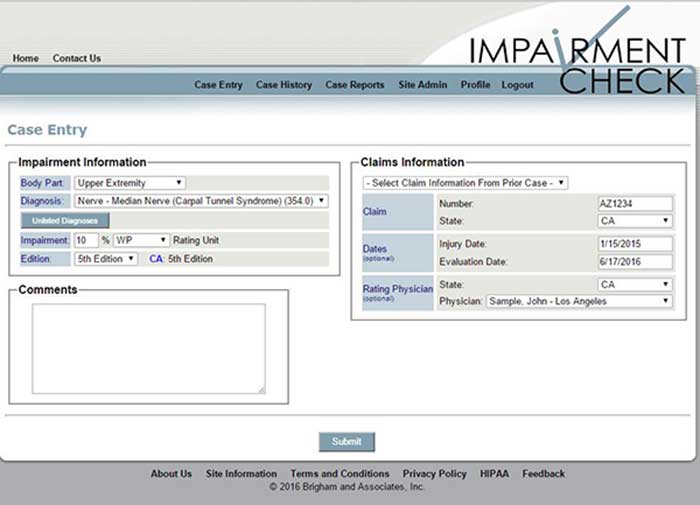
|
| |
|
On submission, the data is compared to Brigham and Associates, Inc. national database of expert ratings for this diagnosis to determine whether the rating is consistent with expected value and to provide the user with information about that impairment. The user receives an immediate report assessing the impairment value (comparing the one submitted to expert values) and providing information on the diagnosis and rating. The rating assessed may, or may not, be supportable. There may be reasons why a specific rating is higher or lower than the usual value associated with the diagnosis. The dashboard graphically demonstrates the findings:
|
| |
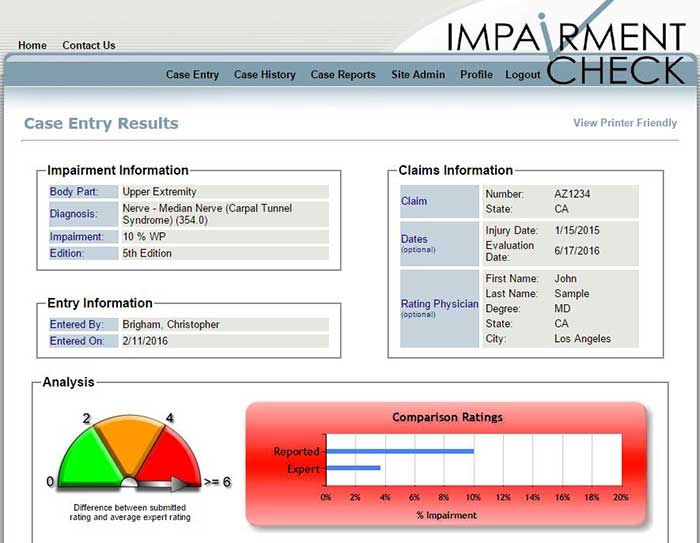
|
| |
|
A discussion of the rating for this case compared to the observed expert average and recommendations are provided:
|
| |
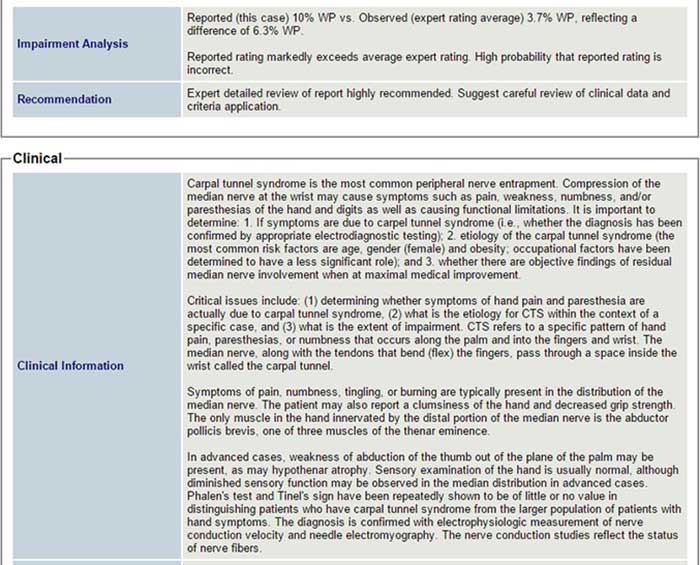
|
| |
If there is a significant difference the user will want to carefully review the rating and/or involve an expert (internal or external to the organization) to determine if the rating is supportable.
Information on maximum medical improvement is graphically displayed:
|
| |

|
| |
|
ImpairmentCheck® provides references to sections and criteria from the Guides and a detailed discussion of the correct rating approach. (Users of ImpairmentCheck® should have available a copy of the Guides for reference.)
|
| |
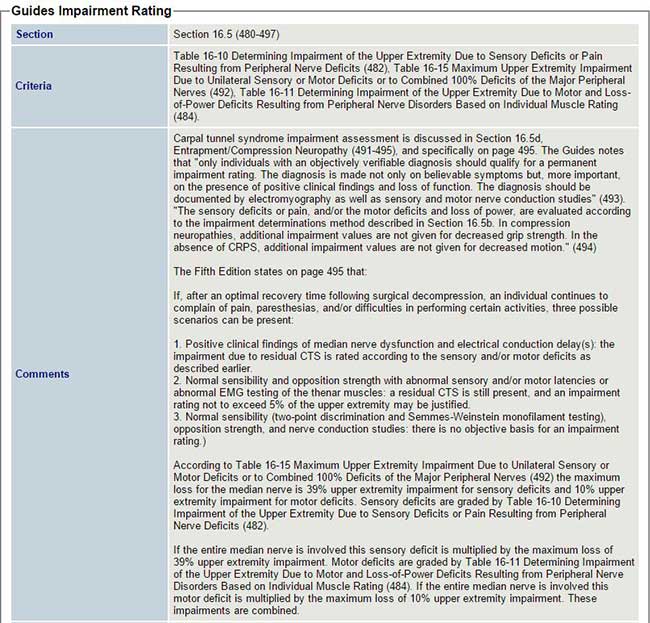
|
| |
|
You are provided with a discussion of the most common errors with reference to the Guides. Therefore, you can determine if these errors may have been made.
|
| |
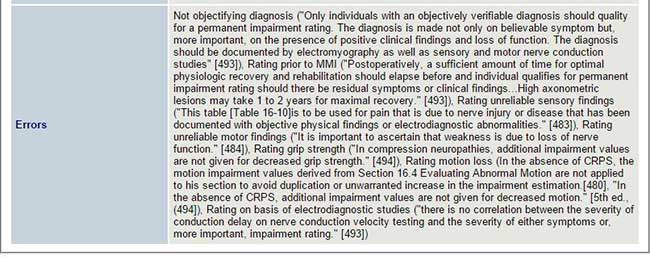
|
| |
|
|
| |
|
ImpairmentCheck® is also used proactively to determine the average impairment value associated with a diagnosis and the probable date of maximum medical improvement. This is used for reserving purposes and to define when it is probable an impairment rating should be obtained. The user specifies the body region, the diagnosis, and the Edition of the Guides to be used, and the date of injury, and is provided with guidance:
|
| |
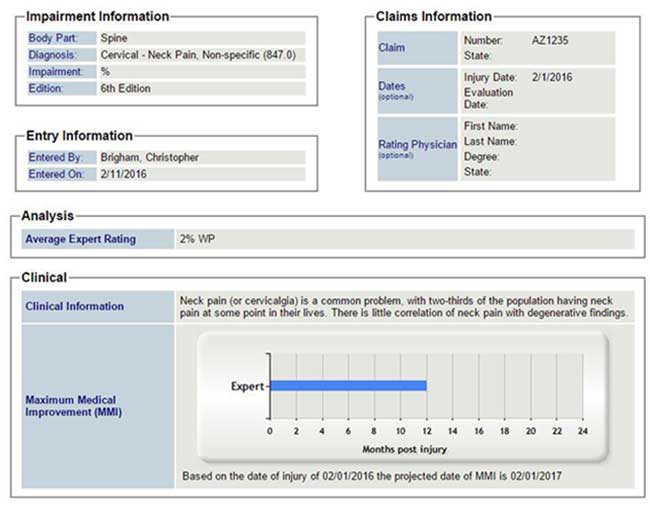
|
| |
|
Guidance on the rating process is also presented:
|
| |
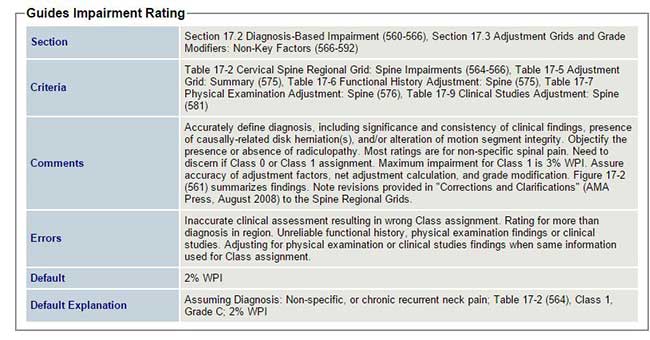
|
| |
|
This information may be provided to the rating physician in advance of the evaluation to assist in developing an accurate impairment rating.
|
| |
|
|
| |
ImpairmentCheck® collects all the data submitted by the user and this data may be used for continuous quality improvement. Reports are provided for case entries, diagnoses and summary, and physician profiling. The reports are displayed on demand and may be exported as Excel (.xls) files.
Reports related to physician performance on rating impairment using your company's data are available. These reports compare the average impairment reported by each physician to the average impairment expected. (There may be reasons why physicians differ from the average; for example, a physician may see cases of different complexity than the average or the physician may tend to under or over rate.)
|
| |
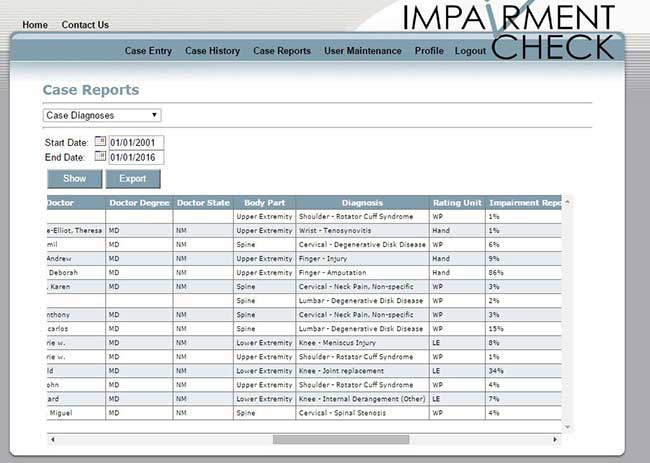
|
| |
|
|
| |
ODG Impairment Check, is available as an add-on to the ODG by MCG User Interface (https://www.mcg.com/odg/odg-solutions/odg-impairment-check/).
ODG Impairment Check allows users to enter an impairment rating value for a diagnosis which then engages the program to generate a graph showing whether or not the rating is reasonable. In addition, immediate guidance is provided regarding management of the rating, clinical issues pertinent to impairment, maximum medical improvement (MMI), the specifics of the impairment assessment process, as well as information on the most common errors and how to manage them.
It can be efficiently integrated into a best practice impairment assessment management process. It can also be used to project the magnitude of impairment associated with a diagnosis; such information is very useful in reserving cases. The likelihood of obtaining an accurate impairment rating is enhanced by printing information for a diagnosis and providing this to the evaluating physician.
Lastly, video educational content is provided on the rating process and users have access to monthly Question and Answer sessions with Christopher R. Brigham, MD, Editor of the Guides Newsletter and AMA Guides, Sixth Edition, and the primary developer of this software system.
ODG Impairment Check is not the same as software systems designed for physicians to be used in developing a rating. The purpose and design is entirely different; it is similar to comparing “apples and oranges” since the two cannot be practically compared. ODG Impairment Check is designed for claims professionals and software rating systems are designed for physicians. Impairment rating systems designed for physicians require incorporating valid and reliable data to develop a rating. Unfortunately, the data entered may be inaccurate and thus the rating is inaccurate; i.e. “GIGO – Garbage In, Garbage Out.”. ODG Impairment Check, designed for claims professionals, provides data and information on the injuries and illnesses most commonly seen. As opposed to physician rating software systems, it provides information on the typical rating value seen, information on pertinent clinical issues, reference to criteria in the Guides, a narrative explanation of the rating process, and discussion of the most common errors. In addition, it provides information that can be shared with physicians and other stakeholders and learning experiences.
ODG Impairment Check is an essential tool in assuring accurate ratings.
|
| |
|
|
|
|